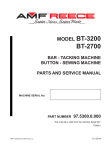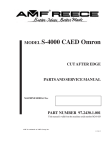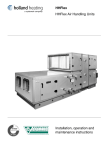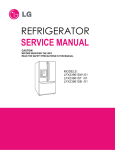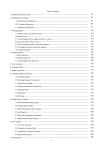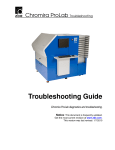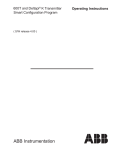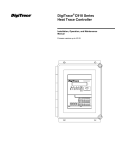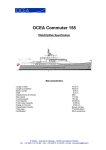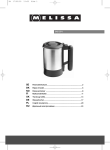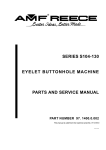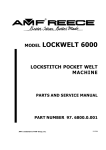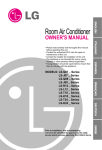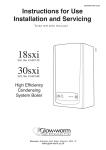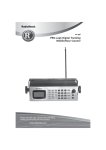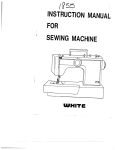Download MODEL EBS Mark II
Transcript
MODEL EBS Mark II ELETRONIC BUTTON STITCHER MACHINE PARTS AND SERVICE MANUAL MACHINE SERIAL No: PART NUMBER 97.7100.0.000 This manual is valid from the machine Serial No.: L710004 AMF je obchodní značka skupiny podniků AMF, Inc. 01/ 2 0 0 9 LIMITED WARRANTY ON NEW AMF REECE EQUIPMENT Warranty provisions: A ninety (90) day limited service labor warranty to correct defects in installation, workmanship, or material without charge for labor. This portion of the warranty applies to machines sold as ”installed” only. A one (1) year limited material warranty on major component parts to replace materials with defects. Any new part believed defective must be returned freight prepaid to AMF Reece, Inc. for inspection. If, upon inspection, the part or material is determined to be defective, AMF Reece, Inc. will replace it without charge to the customer for parts or material. Service labor warranty period shall begin on the completed installation date. Material warranty shall begin on the date the equipment is shipped from AMF Reece, Inc. Exclusions: Excluded from both service labor warranty and material warranty are: (1) Consumable parts which would be normally considered replaceable in day-to-day operations. These include parts such as needles, knives, loopers and spreaders. (2) Normal adjustment and routine maintenance. This is the sole responsibility of the customer. (3) Cleaning and lubrication of equipment. (4) Parts found to be altered, broken or damaged due to neglect or improper installation or application. (5) Damage caused by the use of non-Genuine AMF Reece parts. (6) Shipping or delivery charges. There is no service labor warranty for machines sold as ”uninstalled”. Equipment installed without the assistance of a certified technician (either an AMF Reece Employee, a Certified Contractor, or that of an Authorized Distributor) will have the limited material warranty only. Only the defective material will be covered. Any charges associated with the use of an AMF Reece Technician or that of a Distributor to replace the defective part will be the customer’s responsibility. NO OTHER WARRANTY, EXPRESS OR IMPLIED, AS TO DESCRIPTION, QUALITY, MERCHANTABILITY, and FITNESS FOR A PARTICULAR PURPOSE, OR ANY OTHER MATTER IS GIVEN BY SELLER OR SELLER’S AGENT IN CONNECTION HEREWITH. UNDER NO CIRCUMSTANCES SHALL SELLER OR SELLER’S AGENT BE LIABLE FOR LOSS OF PROFITS OR ANY OTHER DIRECT OR INDIRECT COSTS, EXPENSES, LOSSES OR DAMAGES ARISING OUT OF DEFECTS IN OR FAILURE OF THE EQUIPMENT OR ANY PART THEREOF. WHAT TO DO IF THERE IS A QUESTION REGARDING WARRANTY If a machine is purchased through an authorized AMF Reece, Inc. distributor, warranty questions should be first directed to that distributor. However, the satisfaction and goodwill of our customers are of primary concern to AMF Reece, Inc. In the event that a warranty matter is not handled to your satisfaction, please contact AMF Reece office: Prostejov, Czech Republic Phone: (+420) 582-309-275 Fax: (+420) 582-360-608 e-mail: [email protected] Warranty Registration Card (Please Fax or Mail immediately after installation) Note: All Warranty Claims Void, unless Registration Card on file at AMF Reece HQ Machine model number: (S101, S100, S104, S311, Decostitch, S4000 BH, EBS, EBS Mark II, etc) Manufacturer‘s serial or production number: Installation Site Information: Customer‘s Name: Customer‘s Mailing Address: Customer‘s Telephone Number: Supervising Mechanic‘s or Technician‘s Name: Signature of Supervising Technician: AMF Reece Technician‘s Name: AMF Reece Technician‘s Signature: Type of garment produced at this location? Average Daily Production Expected from this machine? (number of buttonholes, jackets sewn, pants produced, buttons sewn, etc) Any special requirements required at this location? What other AMF Reece Machines are at this location? How can we serve you better? Tovární 837, 796 25 Prostejov, Czech Republic Fax: +420 582 360 606, e-mail: [email protected], website: www.amfreece.com EBS Mark II TABLE OF CONTENTS A - INTRODUCTION 1. General information ............................................................................................................................ 1-1 2. Security labels and arrangement .......................................................................................................... 1-2 3. Terminology of machine parts ............................................................................................................. 1-3 4. Used terminology................................................................................................................................ 1-4 5. Technical conditions ............................................................................................................................ 1-5 6. Coloured marking ............................................................................................................................... 1-6 7. Safety instructions for operators and servencemen .............................................................................. 1-6 8. Special equipment ............................................................................................................................... 1-8 B - MACHINE INSTALLATION 1. Package content .................................................................................................................................. 1-9 2. Adjusting the machine ......................................................................................................................... 1-9 3. Connecting the machine head with control cabinet............................................................................ 1-10 4. Connecting the machine to the distribution of electricity and air ........................................................ 1-11 5. Air distribution - pneumatic schemes ................................................................................................. 1-12 6. Electrical circuit schemes ................................................................................................................... 1-13 7. Thread stand installation .................................................................................................................... 1-14 C - CORRECT USAGE 1. Installation of the machine into the basic position for sewing............................................................. 1-15 2. Needle replacement .......................................................................................................................... 1-16 3. Threading ......................................................................................................................................... 1-17 4. Procedure after sewing the button..................................................................................................... 1-18 D - MACHINE CONTROLS 1. Main menu introduction .................................................................................................................... 1-19 2. Button program setting...................................................................................................................... 1-22 3. Cyclemode description ...................................................................................................................... 1-27 4. Complementary functions ................................................................................................................. 1-29 5. Service menu description................................................................................................................... 1-30 E - MACHINE ADJUSTMENT 1. Set programmes for sewing the button pattern ............................................................................... 1-39 2. Pneumatic cylinder adjustment ....................................................................................................... 1-40 3. Height adjustment of needle bars ................................................................................................... 1-41 4. Adjusting the needle release ........................................................................................................... 1-42 5. Adjusting the machine´s sensor shutter ......................................................................................... 1-43 Revised 01/2009 E-mail: [email protected]; [email protected]; website: www.amfreece.com Phones: +420 582 309 146 (Service), +420 582 309 286 (Spare Parts); Fax: +420 582 360 606 1-i EBS Mark II TABLE OF CONTENTS 6. Looper adjustment ......................................................................................................................... 1-47 7. Adjusting the sewing machine ........................................................................................................ 1-48 8. Stopping the fabric ......................................................................................................................... 1-48 9. Adjusting the chuck height ............................................................................................................. 1-49 10. Adjusting the button loader ............................................................................................................ 1-49 11. Adjusting the clamping lewer of the thread tension...................................................................... 1-50 12. Positioning the tongue of the sewed piece ..................................................................................... 1-51 F - MAINTANANCE 1. Cleaning and maintenance of the machine...................................................................................... 1-52 2. Periodic maintenance ...................................................................................................................... 1-55 3. Machine greasing ........................................................................................................................... 1-56 4. Machine disposal ............................................................................................................................ 1-57 1-ii Revised 01/2009 E-mail: [email protected]; [email protected]; website: www.amfreece.com Phones: +420 582 309 146 (Service), +420 582 309 286 (Spare Parts); Fax: +420 582 360 606 EBS - MARK II A - INTRODUCTION 1. GENERAL INFORMATION EBS Mark II sewing machine is intended for sewing buttonholes on outwear. It has been designed and manufactured to be reliable and easy to operate. Special attention is paid to ensure ease and effective safety for machine operators and servicemen. Safety mechanisms protect both, operators and the machine, and respect valid safety and hygiene provisions for usual technological usage of the machine. Those safety mechanisms contain electrical plug, operation switch (circuit breaker) and covers ensuring safety operation on the machines; only if they are fitted onto the machine correctly. There are information labels on the machine to point out additional danger. Do not remove or damage those labels. In case of damage, order a new one. Mentioned warnings cannot cover all safety aspects and therefore it is very important for an operator to read this manual carefully and understand it well before he starts operating the machine. It will also eliminate errors during machine installation and its operation. Do not put the machine into operation unless you have read entire manuals supplied with the machine and have understood each function and procedure. There are four categories of safety instructions in this manual: DANGER! Ignoring instructions may endanger operator’s life. CAUTION! Ignoring instructions may cause a serious injury of the operator or damage the machine. WARNING! Ignoring instructions may cause damage on the machine or injury of the operator. NOTICE! Breaking procedures may cause functional problems of the machine. We recommend that servicemen from AMF Reece supervise the installation of the machines and initial training of your mechanics and operators. The most effective method ensuring safety of operators working on the machine is a strict safety program including instructions for safety operation. Operators and servicemen should wear safety glasses. Publish 10/2008 E-mail: [email protected]; [email protected]; website: www.amfreece.com Phones: +420 582 309 146 (Service), +420 582 309 286 (Spare Parts); Fax: +420 582 360 606 1-1 EBS - MARK II A - INTRODUCTION 2 . SECURITY LABELS AND ARRANGEMENT Ê Cover removed-warning, electric currentpossible injury Ë Danger - possible injury Ì Covers removend, possible injury Í Machine logo Î Grounding Ï Rotation direction Ð Start button Ñ Removable needle bar cover Ê Ë Ò Eye-guard cover Ó Looper cover Main drive cover emergency Emergency stop button Display Main power switch Ì Î Ï Ñ Í 32 Ò 29 31 Ð 1-2 Ì Ó Publish 10/2008 E-mail: [email protected]; [email protected]; website: www.amfreece.com Phones: +420 582 309 146 (Service), +420 582 309 286 (Spare Parts); Fax: +420 582 360 606 EBS - MARK II A - INTRODUCTION 3 . TERMINOLOGY OF MACHINE PARTS Lower - level desk Foot pedal Stand Electro box Hand wheel Motor Table Thread stand Needle bar 25 26 28 29 30 31 32 Looper (upper/lower) Bedplate Pucker pin Chuck Button loader Thread tension mechanism Tongue Marking light 32 25 30 24 25 28 26 27 29 31 31 28 Publish 10/2008 E-mail: [email protected]; [email protected]; website: www.amfreece.com Phones: +420 582 309 146 (Service), +420 582 309 286 (Spare Parts); Fax: +420 582 360 606 1-3 EBS - MARK II A - INTRODUCTION 4. USED TERMINOLOGY When selecting and sewing styles: Y X Button types and sewing styles: Ê Ë Ì Ì Ì Í All buttons are sewn with hand stitching: Ê 2 - hole buttons Ë 3 - hole button Ì 4 - hole button Í Shank button 1-4 Publish 10/2008 E-mail: [email protected]; [email protected]; website: www.amfreece.com Phones: +420 582 309 146 (Service), +420 582 309 286 (Spare Parts); Fax: +420 582 360 606 EBS - MARK II A - INTRODUCTION 5. T E C H N I C AL CONDITIONS Specifications Application Stitch type Sewing speed Electronic button sewing and wrapping machine sewing with hand stitching technology Hand stitching with floating needle 100 - 200 rpm; adjustable in increments of 5 rpm Sewing style Button parameters 14 - 26mm = = Button height + + X Hole distance Y Neckt height Number of stitches Number of wraps No. of first, final “locking” stitches Stitch depth Stitch option Memory Automatic cycle mode Manual cycle mode Thread length Thread trimming Threading Thread tension Recommended threads Needle system Control panel Marking light Sewing light Button feeding Operating condition Air pressure Machine noise level + Axis X: 3 - 6 mm Axis Y: 3 - 6 mm 0 - 8 mm 1 - 14 0 - 30 0-3 0 - 3 mm Overlaping, alternating 99 patterns 20 cycle modes; 1 cycle mode = 20 differen button patterns 20 cycle modes; 1 cycle mode = 2 different button patterns activated by pedal max. 550 mm Pneumatic Pneumatic 1 - 20 Polyester thread 30, 40, 50, 70, Rice waxed thread size 3, 4, 5 AMF REECE 2000A-38 (100 Nm) Colored touch screen display LED diod LED diods Acording to IEC 364-3, IEC 364-5-51; temperature from +5°C to 40°C, relative air humidity from 30 to 80% 0,55 Mpa = 80 psi 78 dB Machine head 510 mm (height) x 420 mm (width) x 620 mm (depth) Machine head weight Machine weight 40 kg 156 kg Base of machine dimension Adjustable 800 - 1050 mm (height) x 850 mm (width) x 850 mm (depth) Eletrical requirements Line circuit breaker 230V/TN-S 1F+N+PE - 50/60Hz Min. 10A Charakteristic (EN60947-2) Publish 10/2008 E-mail: [email protected]; [email protected]; website: www.amfreece.com Phones: +420 582 309 146 (Service), +420 582 309 286 (Spare Parts); Fax: +420 582 360 606 1-5 EBS - MARK II A - INTRODUCTION 6. COLOURED MARKING Screw - top links: Yellow marks — 1. Loosing and following disassembly of this link causes distinctive intervention to the mechanism adjustment, was done when assembled and sewed off at the that factory. 2. After such an intervention to the mechanism, new adjustment of set mechanism needs to be done and complete check of whole machine adjustment as well. Lubrication locations: Blue marks — Screws and nuts secured against loosing with glue „LOCTITE“. Red marks — CAUTION: Lubrication regime adherance is necessary for protection of the reliable long-term machine operation. 7. SAFETY INSTRUCTIONS FOR OPERATORS AND SERVECEMEN B C A I II III IV WALL, MACHINE ASIDE TABLE CONVEYER SECOND OPERATOR OF A MACHINE I II III IV A 0,9 0,9 1,4 1,5 D B C D 0,6 0,1 0,6 0,6 0,1 0,1 0,2 0 0 0,9 m When installing the machine the manufacturer recomends the minimum clearance mentioned above the machine. Read all of the instructions that follow. DO NOT PUT MACHINE INTO OPERATION UNTIL YOU ARE COMPLETELY FAMILIAR WITH ALL INSTALLATION AND OPERATING INSTRUCTIONS. 1-6 Publish 10/2008 E-mail: [email protected]; [email protected]; website: www.amfreece.com Phones: +420 582 309 146 (Service), +420 582 309 286 (Spare Parts); Fax: +420 582 360 606 EBS - MARK II A - INTRODUCTION DANGER! - Before connecting the machine with the power, make sure all covers are mantled onto the machine. - If any of the safety covers needs to be dismantled, turn the main switch off, and possibly unplug the power from the socket. - Do not connect the machine with the power if any of the covers is dismantled. - Once the machine is connected with the power, check the rotation of the pulley. CAUTION! - Remember the position of the switch so that you can use it from any position. - Make sure that the power, its dimension and circuit breaker provides constant power supply to ensure reliable performance of the machine. - Check that none of the cables is damaged in order to prevent accident injury from happening by touching them. - Damaged covers must be immediately repaired or replaced with new ones. - Never touch rotating parts. - Never put fingers into the sewing area. - Turn the main switch off before you change a needle. - Unplug the power cord from the socket before you clean or maintain the machine. - If you do not work on the machine, disconnect the power with the main switch. - Do not make any modifications in the machine that would endanger its safety. - Be aware that every machine part can become dangerous if they are not handled or serviced the right way. It is important that everybody working with the machine – operate it or do the maintenance on it – gets acquainted with information in this instruction book and in the spare parts manual. WARNING! - Keep maintaining the machine regularly as described in the manual. - If the power is cut off, turn the main switch off. - Do not paint, do not damage, do not remove or change the safety labels. Keep them clean. If they are not legible or you loose them, order new ones at our company and place it onto their original location. - Bind your long hair – it can be caught and winded by the driving mechanism. - Buttons (hooks) on your sleeves must be buttoned up so that loose parts of your outfit are not winded into the driving mechanism. - Do not work onto the machine impaired or intoxicated. - If you are unsure of the operation process, call up a serviceman. - The machine user must provide for illuminating the working area – minimum 750 Lux. Publish 10/2008 E-mail: [email protected]; [email protected]; website: www.amfreece.com Phones: +420 582 309 146 (Service), +420 582 309 286 (Spare Parts); Fax: +420 582 360 606 1-7 EBS - MARK II A - INTRODUCTION 8. SPECIAL EQUIPMENT 8.1. Work light Ê - standard light can be ordered separately, order number 12.0008.4.875 Ê 1-8 Publish 10/2008 E-mail: [email protected]; [email protected]; website: www.amfreece.com Phones: +420 582 309 146 (Service), +420 582 309 286 (Spare Parts); Fax: +420 582 360 606 EBS - MARK II B - MACHINE INSTALLATION 1 . PACKAGE CONTENT 1.1. The package includes the following, if not stated other way in the order: - the composite machine on a base with electric installation - a carboard with accessories (specified in the part about spare parts) - a thread stand Ê - operating instructions with a spare parts catalogue Ê 1.2. Follow the labels on the packaging when unpacking the machine. WARNING: The visible damages of the package must be immediately reported to the carrier. Check the content of the package with the order and immediately report the possible defects to the manufactuter - later complaints will not be responded! 2 . ADJUSTING THE MACHINE 2.1. After unpacking the machine, install it into the designated place. The machine is delivered with a base for works in a sitting position. The recommended height of the lower-level desk from the floor is 870 mm. If you need to change the height loosen the screw Í by turning the hand crank Ë from the accessories. If you need to raise the desk, turn it anticlockwise. Tighten the manual screw Í an the support Ì . 2.2. The supports Ì are used to ensure the stability, by loosening their nuts. Check the level of the adjusted upper table and tighten the nut Í . 2.3. After placing the machine into another place screw the supports Ì after you have loosened their nuts so as the stand leans against the movable wheels Î and the supports do not hamper in movements. Ë Í Ë Ì Î Ì Publish 10/2008 E-mail: [email protected]; [email protected]; website: www.amfreece.com Phones: +420 582 309 146 (Service), +420 582 309 286 (Spare Parts); Fax: +420 582 360 606 1-9 EBS - MARK II B - MACHINE INSTALLATION 3. CONNECTING THE MACHINE HEAD WITH THE CONTROL CABINET The machine is delivered from the manufacturer as completely engaged. The control cabinet Ê of the base includes the electronics necessary for controlling the machine Ï by an attached unit for the modification of compressed air Ë and the vents Ì used to control the pneumatic cylinders of particular mechanism. U1 Ð U2 Ê Ï Ì Ë J1A/B-J10A/B U3 U5 U4 U6 In case of possible demounting, the following should be joined: 3.1. - blue pneumatic hoses J1A/B — J10A/B with electromagnetic vents of the same designation hoses A do the upper screws, B into the lower screws 3.2. - two cables for the servomotor - command/excentr 3.3. - the cable harnesses of stepping motors U1, U6 with cables of the same designation from the cabinet in corresponding supports 3.4. - connecting the LED deadlight + the marking light at the transformers on the cabinet 3.5. - the sensor cables BQ 1...BQ 12 connected to the terminal under the stand table. 1-10 Publish 10/2008 E-mail: [email protected]; [email protected]; website: www.amfreece.com Phones: +420 582 309 146 (Service), +420 582 309 286 (Spare Parts); Fax: +420 582 360 606 EBS - MARK II B - MACHINE INSTALLATION 4 . CONNECTING THE MACHINE TO THE DISTRIBUTION OF ELECTRICITY AND AIR 4.1. The socket of the safety coupler ensures the easy connection of the unit used for the modification of air. On a regular basis we recommend to use the socket 25 KE AK 13. (order no. FESTO 151 776 designation KD -1/4, order no. RECTUS 38044). The unit has a matching input Ê. The input pressure must be higher by at least 1 bar (0,1Mpa) than the output pressure adjusted on the controller Í. Alternatively it is possible to use a different connection of air inlet. In this case the manufacturer rocommends to complement the manual closure in the connection so as is possible to stop the air supply. 4.2. After connecting the air check the set pressure on the controller dial Í. It must be min. 0,55 MPa. The correction can be carried out by pushing out the closure Ë. Increase the set pressure by turning clockwise, decrease it by turning anticlockwise. Push into the closure Ë again. Ë Ê Í 4.3. The electric power supply needs to be of 230V. The elctricity distribution socket for the supply fork must meet the requirements of the norm IEC 364-4-41, it must have a 10A „C“ fuse according to EN 60947-2 (event. 16A „B“ fuse). Other appliances cannot be connected to the circuit of the fused socket. The handwheel Ñ can be turned clockwise. Ñ Note: The machine is fitted with a filter by reason of interference elimination according to EMC - ČSN EN 50081-1 and 50081-2. In case there is a current a protector connected to the supply network you must use the type designed for devices with stray current and with high resistance to surge current in the operating wire (e.g. type „S“). 4.4. The provided warranty does not cover the LED diodes of sewer machine´s lightning. Publish 10/2008 E-mail: [email protected]; [email protected]; website: www.amfreece.com Phones: +420 582 309 146 (Service), +420 582 309 286 (Spare Parts); Fax: +420 582 360 606 1-11 EBS - MARK II B - MACHINE INSTALLATION 5. AIR DISTRIBUTION - PNEUMATIC SCHEMES 1-12 Publish 10/2008 E-mail: [email protected]; [email protected]; website: www.amfreece.com Phones: +420 582 309 146 (Service), +420 582 309 286 (Spare Parts); Fax: +420 582 360 606 EBS - MARK II B - MACHINE INSTALLATION 6. ELECTRICAL CIRCUIT SCHEMES Publish 10/2008 E-mail: [email protected]; [email protected]; website: www.amfreece.com Phones: +420 582 309 146 (Service), +420 582 309 286 (Spare Parts); Fax: +420 582 360 606 1-13 EBS - MARK II B - MACHINE INSTALLATION 7 . THREAD STAND INSTALLATION 7.1 Attach the thread stand Ê with its accessories according to the figure. 7.2 The appropriate position when tightening its clamps Ë is on the back side of the stand app. ... 450 mm from left. Ê cca 450 mm 1-14 Ë Publish 10/2008 E-mail: [email protected]; [email protected]; website: www.amfreece.com Phones: +420 582 309 146 (Service), +420 582 309 286 (Spare Parts); Fax: +420 582 360 606 EBS - MARK II C -CORRECT USAGE 1 . INSTALLATION OF THE MACHINE INTO THE BASIC POSITION FOR SEWING After connecting the machine with the fork on it is possible to light the sewing space by LED diodes, use the switch Ð of the upper transformer on the electric cabinet. The switch Ñ of the lower transformer is used to light the adjusting. 1.1. Turn on the main switch Ê by turning it clockwise in to the position I ON. 1.2. The display is activated and lit. The screen with the note GOT 1000 appears. Wait until the main screen Ì appears on the display. 1.3. If the error message E02 in the field Í is displayed on the screen (the machine is not in its basic . If no error messages position), turn the handwheel Ë until E01 appears. Then press the button are displayed see truobleshooting. 1.4. The machine is ready for operation when a green notice is displayed in the field Í (See the display description in D1). Ë Ð Ñ Ì Í Ê Publish 10/2008 E-mail: [email protected]; [email protected]; website: www.amfreece.com Phones: +420 582 309 146 (Service), +420 582 309 286 (Spare Parts); Fax: +420 582 360 606 1-15 EBS - MARK II C - CORRECT USAGE 2 . NEEDLE REPLACEMENT Note: Use only Reece 00200038….needles ( for 30...70 thick threads). The load needles in the needle bar D =2 mm. Turn off the electric power supply before every handling by using the stop button.The error message E 99 appears on the display. 2.1. Check if the upper looper Ê is not in the area of the upper cover the needle bar Ë , then release the cover through the hole in the cover Ï , use a stick (screwdriver), the button is to the left of the passing wires and the hose of the pneumatic cylinder Ð . Lift up the cover Ë to the position when the latch fixes it. Warning: When the cover is open there is risk o injury caused by the threading hook Ñ which is located in the area of the lifted cover. 2.2. Press the insert of the needle bar by pulling the nut Î of the needle bar Ò . Put the needle into the needle hole, with the facing eye facing the operator. 2.3 The case of the needle bar presses the needle after you loose the nut Î .Check the pressing of the needle by pulling it. 2.4 By turning the handwheel carry out two handovers of the needle between the upper and the lower needle bar and stop in approximately in the middle position when upper looper is to the right of the needle bar . 2.5. Close the needle bar cover Ë pulling the hand nut that is placed above behind the cover suspender and press it in the lower position so as it is fixed by the button fuse Ó . Î Ò Í Ì Ë Ñ Ï Ð Ò Ê 1-16 Publish 10/2008 E-mail: [email protected]; [email protected]; website: www.amfreece.com Phones: +420 582 309 146 (Service), +420 582 309 286 (Spare Parts); Fax: +420 582 360 606 EBS - MARK II C - CORRECT USAGE 3 . THREADING 3.1 Lead the thread from the stand through the tightener Ê app. 50 mm into the leading hole Ë of the mechanism for pneumatic threading. Ê Ì Ë 3.2 Activate the symbol of threading on the main screen. The thread gets in the area of the needle when the threading hook Ì is at the needle. The operator leads the thread onto the threading hook Ì. 3.3 The threading into the needle is carried out automatically if you step on the stand pedal. The operator sets the thread reserve lenght of the thread necessary for one sewing cycle by pulling it. Note: The thread reserve lenght is dependent on the chosen programme. The chosen type of buttons, the number of stitches, the neck height, the number of wrappings affect it. Publish 10/2008 E-mail: [email protected]; [email protected]; website: www.amfreece.com Phones: +420 582 309 146 (Service), +420 582 309 286 (Spare Parts); Fax: +420 582 360 606 1-17 EBS - MARK II C - CORRECT USAGE 4. PROCEDURE AFTER SEWING THE BUTTON Í 4.1. Set the machine its basic position for sewing according to section C1 of this part and check id the needle is in the upper needle bar. 4.2. Thread according to section C3. Warning: Check the display parameters in accordance with the chosen button. 4.3. Put the button on the appropriate holder Ì . Press the foot pedal so as the button is automatically placed into the chuck under the needle bar. Note: We recommend using a gauge from the accessories instead of the button and programming no. 95. You should use simple Tesil fabric. Ì Ë Ê 4.4. Place the sewed piece on the tongue Ê . The cross of the marking light must overlap the sign used for placing the button on the sewed piece. The piece must be evenly alignet and must freely encircle the tongue. 4.5. Push/press the tongue into the machine up to the place where the machine fastens the piece. Carry out a repeated check of the piece surface evenness. 4.6. Press the foot pedal so as the machine puts the auxilary bottom end Í onto the tongue with the part for fixing the piece at the same time, it passes on the necessary for threading. 4.7. Lead the thread menually onto the threading hook in the upper direction. Press the foot pedal again. The threading hook leads the thread into the needle. Note: If the hook damages the thread, it is necessary to cut off the damaget thread in the place where it was damaged. 4.8. Manually pull out thread and choose the necessary lenght of the thread for sewing one button. The lenght depends on the number of stitches, the wrapping, the bight and the number of button holes and the sewing type. The thread must lie freely on the sewed piece. When you use a sample gauge and programme 95 pull out an app. 350 long thread. Now it is possible to put the second button into the holder. 4.9. Press the button Ë . Hold it for app. 0,5 sec. until the thread is loaded. The machine sews the button and cuts off the thread - the second button is put into the chuck. 1-18 Publish 10/2008 E-mail: [email protected]; [email protected]; website: www.amfreece.com Phones: +420 582 309 146 (Service), +420 582 309 286 (Spare Parts); Fax: +420 582 360 606 EBS - MARK II D - MACHINE CONTROLS 1. MAIN MENU INTRODUCTION A colored touch screen display GOT 1000 is used to control individual machine functions. For easy use of the display and better orientation please read carefully the section D-Machine controls before programming the sewing parameters. 1.1 COMMONLY USED DISPLAY ICONS - Machine status indicator / green is ON - machine is ready to sew, red is ON - machine is in operation - Error message / press to enter error description screen - Service mode / press to enter service menu operated only by service mechanic - Threading / press to activate thread blowing system - Cycle mode / press to enter cycle mode screen - Step back / press to return to previous machine operation - Home position / press to set machine home position - Program number indicator / press to enter numeric keyboard to select program number - Button parameters indicator / short cut to button parameters screen - Daily counter / press to enter the counter screen - Customized program name / press to enter alphabetic keyboard to set program name - Stitch number indicator / press to enter button style screen - Neck height and wrap indicator / press to enter button neck parameters screen - Stitch style indicator / press to enter stitch style screen - Locking stitch / press to enter locking stitch parameter screen - Sewing speed indicator / press to enter sewing speed parameter screen Publish 10/2008 E-mail: [email protected]; [email protected]; website: www.amfreece.com Phones: +420 582 309 146 (Service), +420 582 309 286 (Spare Parts); Fax: +420 582 360 606 1-19 EBS - MARK II D - MACHINE CONTROLS - Electronic thread tension / press to enter thread tension parameter screen - Return / press to return to previous screen - Cancel/ press to return to previous screen without changing the settings - Delete/ press to delete all typed characters - Delete/ press to delete last typed character - Save/ press to save all settings and return to previous screen 1-20 Publish 10/2008 E-mail: [email protected]; [email protected]; website: www.amfreece.com Phones: +420 582 309 146 (Service), +420 582 309 286 (Spare Parts); Fax: +420 582 360 606 EBS - MARK II D - MACHINE CONTROLS 1.2 MAIN MENU DISPLAY OVERVIEW Please see below brief overview of used displays for easy orientation and programming. (D 4.2) (D 2.3) (D 2.2) Button style setting Error message (D 4.1) Programe name setting Counters (D 5.0) Shortcut to button parameter settings Neck height and wrap setting Service menu (D 2.6) Cycle mode setting (D 3.1) (D 2.7) Button programme setting Stitch style setting (D 2.4) (D 2.9) (D 2.5) (D 2.10) Thread tension setting Locking stitch setting (D 3.2) (D 2.8) Publish 10/2008 E-mail: [email protected]; [email protected]; website: www.amfreece.com Phones: +420 582 309 146 (Service), +420 582 309 286 (Spare Parts); Fax: +420 582 360 606 (D 2.1) 1-21 EBS - MARK II D - MACHINE CONTROLS 2. BUTTON PROGRAM SETTING 2.1 BUTTON PROGRAM Before setting any button parameters described in sections D 2.2-2.10 a button program has to be selected. The machine has 99 different button programs. Programs 1 to 94 are available and can be programmed by operator. Programs 95 to 99 are default factory settings and can not be changed. Please refer to section E-1 of this manual for detailed description. To set new button program, press, icon Ê on the main screen to enter numerical keyboard. Type the required program number within range 1 to 94. The typed number appears on the top of the numerical keyboard screen, see point Ë. Save the setting and return to main screen by pressing icon Ì. Once the button program is selected, start programming button parameters according to section D 2.3 -2.10. All set button parameters are automatically saved under selected button program. In case you need to return to already programmed button program, follow the steps for setting new button program. 2 Typed program number 3 Save and return to main screen 1 2.2 CUSTOMIZED PROGRAM NAME To each button program can be assigned customized program name. This is used especially for better orientation within programs. The program name is combination of up to 15 alphabetic and numeric characters. To set program name, press, icon Ê on the main screen to enter numerical and alphabetic keyboard. Type the specific program name (max. combiation of 15 alphabetic and numeric characters). Typed characters appear on top of main screen, see point Ë. Save the setting and return to main screen by pressing icon Ì. 1 2 Typed program name 3 1-22 Save and return to main screen Publish 10/2008 E-mail: [email protected]; [email protected]; website: www.amfreece.com Phones: +420 582 309 146 (Service), +420 582 309 286 (Spare Parts); Fax: +420 582 360 606 EBS - MARK II D - MACHINE CONTROLS Follow the below steps in sections D 2.3 - D 2.10 to set button style and further button parameters. Caution! Please ensure that correct conversion kit (button holder, pucker pin, tongue) is installed according to the button style selected in the program. Please refer to parts section of this manuale page 3-46 of this manual for detailed description. 2.3 BUTTON STYLE Press icon Ê on the main screen to enter button style screen. Press one of the icons under point Ë to select required button style. When sewing 3, 4-hole or shank button it is necessary to select the stitching method by icons Ì or Í. Press icon Ì to select overlapping stitching method (machine sews first all stitches on the left pair of holes and then all stitches on the right pair of holes). Press iconÍ to select alternating stitching method (machine alternately sews right and left pair of holes). Press icon Î to enter button parameter screen to program additional parameters of selected button. For further explanation refer to section D 2.4 for 2, 3, 4 - hole button and D 2.5 for shank button. 2.4 2, 3, 4 - HOLE BUTTONS After selectinc reqeuired button style in see section D 2.3 continue with button parameter setings. Press icon Ê on the button style screen to enter button parameter screen for buttons with hole. Press icon Ë to set hole spacing in X-axis and icon Ì in Y-axis. Refer to picture Ð for detailed explanation. The hole spacing range is 3-6 mm. Press icon Í to set number of stitches according to definition A 4 within range 1-14 stitches. Press iccon Î to set button height important for button feeding and neck wrapping. The button height range is 1,0-3,5 mm and is measured from chuck center to the bottom edge of button. Ð X Y Publish 10/2008 E-mail: [email protected]; [email protected]; website: www.amfreece.com Phones: +420 582 309 146 (Service), +420 582 309 286 (Spare Parts); Fax: +420 582 360 606 1-23 EBS - MARK II D - MACHINE CONTROLS 2.5 SHANK BUTTON After selectinc reqeuired button style in see section D 2.3 continue with button parameter setings. Press icon Ê on the button style screen to the enter button parameter screen for shank button. Press icon Ë to set stitch spacing in fabric within range 0-6 mm. When seting 0 mm spacing, stitches are sewn into one place. Press icon Ì to set number of stitches according to definition section A 4 within range 1-14 stitches. Press icon Í to set needle position that is important for button feeding and button stitching. The needle position is the lowest point of the shank where the needle is passed through. This is measured from chuck center within range 2 to 5 mm. Number of stitches Stitch spacing in fabric 2 3 5 1 4 For quick checking and adjustments use icon Î on the main screen to enter directly button parameter screen (see section D - 1.2). Needle position 2.6 BUTTON NECK Press icon Ê on the main screen screen to enter neck parameter screen. Press icon Ë to set neck height within range 0-8 mm. This range automatically lowers when the button height (see section D 2.4, point 5) is set more than 1,8 mm or the needle position (see section 2.5, point 4) is set more than 4 mm. Press icon Ì to set number of wraps within range 0-30 wraps. When setting 0, the wrap in not performed. Press icon Í to set position of first wrap from fabric within range 0-3 mm. Press iccon Î to set position of final wrap closer to button within range 0-2 mm (recomended when sewing rounded or bevelled buttons). When extreme values are set as parameters Ë , Í and Î, the wrap can not be performed and the graphic wrap symbol on the main screen, shown as Neck height 1 1-24 Number of wraps 2 3 4 5 First wrap position from fabric . Final wrap position from bottom side of button Publish 10/2008 E-mail: [email protected]; [email protected]; website: www.amfreece.com Phones: +420 582 309 146 (Service), +420 582 309 286 (Spare Parts); Fax: +420 582 360 606 EBS - MARK II D - MACHINE CONTROLS 2.7 STITCH STYLE (SHOW, BLIND, STANDARD STITCH) Press icon Ê on the main screen to enter stitch style screen. Press icon Ë, Ì or Í to select stitching style - blind (all stitches blind), show (one stitch shown, rest blind), standard stitch (all stitch visibility inside the garment). Depending on selection appropriate icons of stitch depth Î, Ï are highlighted. Press icon Î to set stitch dept for blind stitch within range 0-3 mm from garment facing. Press icon Ï to set stitch dept for show stitch within range 0-3 mm from garment facing. 2.8 LOCKING STITCH Press icon Ê on the main screen to enter locking stitch parameter screen. Press icon Ë to set number of locking stitches sewn to fabric before button attaching. The stitch range is 0-3 stitches. Press icon Ì to set number of final locking stitches sewn trough wrapped button neck (needle is passed through the neck) in case of buttons with hole. In case of shank button the final locking stitches are sewn to fabric as the first locking stitches. The stitch range is 0-3 stitches. Number of first locking stitches 1 Number of final locking stitches 23 3 2 Publish 10/2008 E-mail: [email protected]; [email protected]; website: www.amfreece.com Phones: +420 582 309 146 (Service), +420 582 309 286 (Spare Parts); Fax: +420 582 360 606 1-25 EBS - MARK II D - MACHINE CONTROLS 2.9 THREAD TENSION The thread tension can be separately programmed for four different sewing phases-button stitching, neck wraping, show stitch, locking stitches. Press icon Ê on the main screen to enter thread tension parameter screen.Press icon Ë to set thread tension for stitching the button within the range 1-20. Press icon Ì to set therad tension for wrapping the button within the 1-20. Press icon Í to set thread tension of show stitch and first locking stitch within the range 1-20. Press icon Î to set thread tension for final locking stitches the range 1-20. 2 stitching Button thread tension 23 1 Neck wrapping thread tension 3 4 Show stitch and first locking stitches thread tension 5 Final locking stitches thread tension 2.10 SEWING SPEED The sewing speed can be separately programmed for three different sewing phases-button stitching, neck wrapping and first and final locking stitches. Press icon Ê on the main screen to enter sewing speed parameter screen. Press icon Ë to set sewing speed for stitching the button within the range 100-200 spm in the increments of 5 spm. Press icon Ì to set sewing speed for wrapping the button within the range 100-200 spm in the increments of 5 spm. Press icon Í to set sewing speed Of first and final locking stitches within the rang 100-200 spm in the icrements of 5 spm. 1-26 Publish 10/2008 E-mail: [email protected]; [email protected]; website: www.amfreece.com Phones: +420 582 309 146 (Service), +420 582 309 286 (Spare Parts); Fax: +420 582 360 606 EBS - MARK II D - MACHINE CONTROLS 3. CYCLE MODE DESCRIPTION Cycle mode function enables sewing of different button programs with different settings in one repeating sewing cycle. Available are 2 different cycle modes – standard and prompt. Please note that all setting are described starting from the main (standard) cycle mode screen. To enter the cycle mode screen see section D 1.2. 3.1 STANDARD CYCLE MODE The standard cycle mode can accommodate up to 20 different button programs to be sewn in one cycle mode program. Machine has memory of 20 different standard cycle mode programs 3.1.1 PROGRAMMING THE STANDARD CYCLE MODE In case the standard cycle mode screen is not available, the prompt cycle mode screen is on and it is necessary to press icon to switch the machine to the standard cycle mode program. Once the standard cycle mode screen comes up, start programming the cycle sewing. Press icon Ê on the standard cycle mode screen to enter numerical keyboard and select the cycle mode program number within the range 1 to 20. Under the selected cycle mode program, enter required button programs for positions 1-20. Press required position (1-20), see point Ë , to enter numerical keyboard and type particular number of button program (1-94) that you have save in the machine memory before. See section xxx. Note that the cycle mode can work only with pre-programmed button programs. The end of cycle program is define by entering number “0” in the position following upon the last entered button program, see point Ì . This means that the cycle mode is finished and the sewing starts from beginning. Note: The currently sewn button program/ position is highlighted in red. Icons under point Í are used for quick setting and adjustment and have same functions as icons used on the main screen, see section D 1.2 Movement in the cycle mode Number of the stored cycle mode 5 1 Switching to the manual cycle mode 3 2 Information about the sewed button 4 Numbers of programmes sewed in the cycle mode Threading Return to the previous position Publish 10/2008 E-mail: [email protected]; [email protected]; website: www.amfreece.com Phones: +420 582 309 146 (Service), +420 582 309 286 (Spare Parts); Fax: +420 582 360 606 1-27 EBS - MARK II D - MACHINE CONTROLS 3.2 PROMOD CYCLE MODE The prompt cycle mode is designed only for 2 different button programs to be sewn in one cycle mode program. Machine has memory of 20 different prompt cycle mode programs. 3.2.1 PROGRAMMING THE PROMT CYCLE MODE To enter the prompt cycle mode screen press icon on the standard cycle mode screen. Press icon Ê on the prompt cycle mode screen to enter numerical keyboard and select the cycle mode program number within the range 1 to 20. Under the selected cycle mode program, enter required button programs for position 1, see point Ë and position 2, see point Ì . Press required position, to enter numerical keyboard and type particular number of button program (1-94), see section E 1. Note that the cycle mode can work only with preprogrammed button programs. Bring machine to the position ready for sewing (green light is on), see section xxx. Press start button to sew the button program saved in the position 1, see point Ë. Press machine pedal to switch the machine to the button program saved under position 2, see point Ì. To start sewing, press the start button. Note: The currently sewn button program/ position is highlighted in red. Icons under point Í are used for quick setting and adjustment and have same functions as icons used on the main screen, see section D 1.2. In case the machine is not in the position ready for sewing (green light is not on), the icons Ë and Ì can be also used for quick checking of adjusted parameter. Number of the stored cycle mode 1 6 6 Information about the sewed button 1-28 4 5 Programme sewed with an impressed pedal Programme sewed with a pressed pedal Threading Return to the previous position Publish 10/2008 E-mail: [email protected]; [email protected]; website: www.amfreece.com Phones: +420 582 309 146 (Service), +420 582 309 286 (Spare Parts); Fax: +420 582 360 606 EBS - MARK II D - MACHINE CONTROLS 4. COMPLEMENTARY FUNCTIONS 4.1 BUTTON COUNTERS Machine has two different counters - daily and total used as shift, batch production counter etc. of sewn daily production counter can be set within the range overall button production and indicates the machines‘ production counter. The daily counter can be buttons and can be deleted when needed. The 0-30 000. The total production counter counts wear out. This counter can not be deleted. 4.1.1 SETTING DAILY PRODUCTION COUNTER Press icon Ê on the main screen to enter counter screen. Press icon Ë to delete daily production counter or icon Ì to set daily production counter. In case icon Ì is selected numerical keyboard appears on top of counter screen. Enter require number of sewn buttons within range 0-30 000. Typed number appears on the top of numerical keyboard screen, see point Í. Press icon Î to save all or settings and return to the counter screen. The production can be counted on ascending descending form. Press icon Ï to selected operation direction of daily production counter. Typed program number Total prodaction counter 1 4 3 6 2 5 Daily production counter Selection of daily production counter operation direction Delete daily production counter 4.2 ERROR MESSAGES In case fault occurs on the machine, error message appears on the main screen. Press icon Ê on the main screen to enter error description screen. The error description screen indicates error number (first line), error description (second line) and probable solution of occurred fault (third line). Please refer to section 3 Trouble shootings of this manual for detailed description Of error massages. Publish 10/2008 E-mail: [email protected]; [email protected]; website: www.amfreece.com Phones: +420 582 309 146 (Service), +420 582 309 286 (Spare Parts); Fax: +420 582 360 606 1-29 EBS - MARK II D- MACHINE CONTROLS 5. SERVICE MENU DESCRIPTION 5.1 SERVICE MENU DISPLAY OVERVIEW Please see below brief overview of used displays of service menu. The service menu can be operated by trained service mechanic only and is divided into several levels depending on required qualification and frequency of service settings. Each level is protected by specific password, please see section D-5.2 for details. Please note that all settings are described step by step starting from the service menu screen. To enter the service menu screen see section D-1.2. (D 5.4) (D 5.2) (D 5.6) Firmware Jogging screen (D 5.5) (D 5.3) Password submit screen Program copy screen Basic parameters screen Sensor test screen Additional motors test screen (D 5.7) (D X.X) Sewing drive test screen (D 5.8) Valve tests screen 1-30 (D X.X) (D X.X) Bad plate motor test screen Publish 10/2008 E-mail: [email protected]; [email protected]; website: www.amfreece.com Phones: +420 582 309 146 (Service), +420 582 309 286 (Spare Parts); Fax: +420 582 360 606 EBS - MARK II D- MACHINE CONTROLS 5.2 PASSWORD SUBMITTING The service menu has 3 different setting levels. Level II and III are protected by passwords, see section D-5.2.1 To submit the password press icon Ê on the service menu screen to enter numeric keyboard. Type the appropriate numeric code and press icon Ë to save all settings. 1 2 5.2.1. PASSWORD LEVELS Please see below brief overview of service menu setting levels including relevant passwords. Password LEVEL I no password Password LEVEL II password 159 Password LEVEL III password 5632 Also! Once the password is submitted all service functions protected by this specific password are activated. This means, when is submitted for example password level II, all functions from level II, are available. In case password level III is submitted, the service functions protected by password level II are available without submitting password level II. Publish 10/2008 E-mail: [email protected]; [email protected]; website: www.amfreece.com Phones: +420 582 309 146 (Service), +420 582 309 286 (Spare Parts); Fax: +420 582 360 606 1-31 EBS - MARK II D - MACHINE CONTROLS 5.3 PROGRAM COPY Program copy screen enables easy and quick copying of selected button program under new required program number. Press icon Ê on the service menu screen to enter program copy screen. Press icon Ë to enter numerical keyboard. Select program number you want to copy. Press icon Ì to save the setting and return to program copy screen. Press icon Í to enter numerical keyboard. Select program number under witch you want. Press icon Î save the setting and return to program copy screen. Press icon Ï to process the program copying, see point Ð. 1 3 2 6 4 5 5.4 FIRMWARE INFORMATION Information screen provides the user with information such as display firmware version, PLC firmware version and manufacturer‘s contacts. To enter information screen, press icon Ê on the service menu screen. 1 PLC firmware version Display firmware version 1-32 Publish 10/2008 E-mail: [email protected]; [email protected]; website: www.amfreece.com Phones: +420 582 309 146 (Service), +420 582 309 286 (Spare Parts); Fax: +420 582 360 606 EBS - MARK II D - MACHINE CONTROLS 5.5 BASIC PARAMETERS The basic parameter screen enables selection of display language, activation of pneumatic threading, activation of automatic button feeding, activation of automatic fabric holder and automatic servo home positioning. To enter basic parameter screen, press icon Ê on the service menu screen. Icons in point Ë are used to select required display language (English, Czech or Italian) especially used on error description screen. Icon Ì is used to activate/deactivate pneumatic threading system. In case icon Ì is activated threading device is controlled by pedal. In case icon Ì is not activated threading device has to be controlled manually. Icon Í is used to set thread blowing time of blowing system. Activation of the thread blowing system itself is done by pedal. To obtain requrired thread end increase or decrease the set time. Icon Î is used to activate/deactivate automatic button feeding. In case icon Î is activated machine automatically loads another button every time sewing cycle is finished. Icon Ï is used to activate/deactivate automatic closing of fabric holder. In case icon Ï is activated using fabric holder is closed automatically and it is necessary to set dealy time of fabric holder icon Ð. This delay time is a time from closing tongue till closing fabric holder. In case icon Ï is not activated fabric holder is controlled by pedal. Icon Ñ is used to activate/deactivate automatic servo home positioning. In case icon Ñ is activated the servo is brought to its home position every time home position icon on the main screen is pressed. In case icon Ñ is not activated servo has to be brought to its home position manually by using hand wheel on machine head. Language 3 1 2 Pneumatic threading 3 Automatic button feeding 5 4 7 6 8 Publish 10/2008 E-mail: [email protected]; [email protected]; website: www.amfreece.com Phones: +420 582 309 146 (Service), +420 582 309 286 (Spare Parts); Fax: +420 582 360 606 Thread blowing time Delay time of fabric holder Automatic closing of fabric holder Automatic servo home positioning 1-33 EBS - MARK II D - MACHINE CONROLS 5.6 JOGGING Jogging function enables the user to monitor button sewing process and check all set parameters. Jogging function is protected by password level II, see section D 5.2. Caution: Before using jogging function, please make sure, button is loaded to chuck and machine is in position ready for sewing. This means the green start button is on, see section C 1 for details. 5.6.1 JOGGING SCREEN DESCRIPTION Press icon Ê on the service menu screen to enter jogging screen. Press icon Ë to activate/ deactivate , jogging function is deactivated jogging function. Jogging function is activated . In case jogging function is activated machine can perform jogging in small or big steps which are set in degrees by using icon Î (small step) or Ï (big step). To achive jogging itselve press icon Ì (small step) or Í (big step). Current positions of all motors are displayed in the middle of jogging screen, see point Ð. While jogging, it is possible to return to the main screen to adjust any sewing parameters. The new parameters are effective immediately. To access sewing area better, icons Ò and Ó can be used. Joging activation Small step Big step 1 2 3 5 4 6 7 8 1 1-34 Close or Close or open fabric open chuck holder 9 Currat motors positions 10 Close or open tongue Publish 10/2008 E-mail: [email protected]; [email protected]; website: www.amfreece.com Phones: +420 582 309 146 (Service), +420 582 309 286 (Spare Parts); Fax: +420 582 360 606 EBS - MARK II D - MACHINE CONROLS 5.7 SENSOR TESTS Sensor test screen enables user to check functions of all sensors. To enter sensor test screen press icon Ê on the service menu screen. Sensor test screen is protected by password level II, see section D 5.2. - X axis home position - Y axis home position - Thread tension home position - Home position of chuck vertical movement - Button loader home position - Home position of chuck horizontal movement Ñ - Tongue position for material clamping Ò - Horizontal chuck position Ó - Vertical chuck position - Servo home position - needle is in highest position - Ë Ì Í Î Ï Ð 2 Therading device Servo home position - lopper basic position Servo motor movement control pulses Servo error Emergency stop Pedal Start button Low air pressure 3 8 4 9 5 10 11 6 9 7 12 13 11 1 14 15 16 18 19 17 PLC program flags for service purpoces of AMF Reece mechanics only 5.8 VALVE TESTS Vavle test screen enables user to check functions of all valves including relevant sensors. To enter valve test screen press icon Ê on the service menu screen. Valve test screen is protected by password level III, see section D 5.2. Ë Ì Í Î Ï Ð - Threading device Eye-guard cover opening Chuck closing Fabric holder Tongue closing Top needle bar lifting Ñ - Chuck rotation Ò - Tongue opening Ó - Thread trimming - Thread blowing system - All valves demo 3 4 9 5 2 6 11 11 7 10 1 8 Publish 10/2008 E-mail: [email protected]; [email protected]; website: www.amfreece.com Phones: +420 582 309 146 (Service), +420 582 309 286 (Spare Parts); Fax: +420 582 360 606 9 12 1-35 EBS - MARK II D - MACHINE CONTROLS 5.9 SEWING MOTOR TEST The sewing servomotor test screen enables the user to test function of main sewing servo motor. Sewing drive motor test screen is protected by password level III, see section D 5.2. To enter sewing servomotor test screen press Ê on the service menu screen. Please note that before using any of screen functions it is necessary to close eyeguard cover by pressing icon Ë on sewing servomotor test screen. Icon Ì is used to activate/deactivate servomotor. Servomotor is activated deactivated , servomotor is . In case the servomotor is deactivated, the hand whel can be used to perform the servomotor movement. Icon Í is used to start/stop continous movement of servomoor. Icon Î is used to move servomotor for 10 degrees only. Icon Ï is used to set looper basic position; it means initial position for sewing. Icon Ð is used to set servomotor home position, where needle is in its highest position. This icon together with icon Ñ (icon to set upper looper position) an icon Ò (icon to set lower looper position) is used to adjust loopers position, see section E 6 for more details. Icon Ó is used to set rotation speed for testing the servomotor. This preset speed is used for functions Í, Î, Ñ and Ò. Current servo motor position 4 5 10 9 1 5 1-36 3 8 6 7 Close or open check 2 Statuses of servomotor home position sensors Publish 10/2008 E-mail: [email protected]; [email protected]; website: www.amfreece.com Phones: +420 582 309 146 (Service), +420 582 309 286 (Spare Parts); Fax: +420 582 360 606 EBS - MARK II D - MACHINE CONTROLS 5.10 X-Y MOVEMENT MOTORS TEST X-Y movement motors test screen enables user to adjust and test bedplate movements in X and Y axis and chuck movement in Y axe. X-Y movement motors test screen is protected by password level III, see section D 5.2. To enter X-Y movement motors test screen press icon Ê on the service menu screen. Information in point Ë provides user with current positions in X, Y axis. Icons in point Ì are used to test X-Y movements in all directions. Icons in point Í are used to set home position in case position of screening is changed. Icons in point Î are used for electronic adjustments of home position within the range ± 1,5 mm. 2 3 4 5 Bedplate movement in X-axis Bedplate movement in Y-axis Chuck horizontal movement 1 Close or open chuck Statuses of home position sensors Publish 10/2008 E-mail: [email protected]; [email protected]; website: www.amfreece.com Phones: +420 582 309 146 (Service), +420 582 309 286 (Spare Parts); Fax: +420 582 360 606 1-37 EBS - MARK II D - MACHINE CONTROLS 5.11 OTHER MOTORS TEST Other motors test screen enables user to adjust and test button feeding motors and thread tension motor. Other motors test screen is protected by password level III, see section D 5.2. To enter other motors test screen press icon Ê on the service menu screen. Information in point Ë provides user with current vertical position of chuck, button loader and thread tension position. Icons in point Ì are used to test particular movements in all directions. Icons in point Í are used to set home position in case position of screening is changed. Icons in point Î are used for electronic adjustments of home positions within the range ± 1,5 mm for vertical chuck position, ± 5,0° for button loader and ± 1,5° for thread tension. 2 3 4 5 Chuck vertical movement Button loader movement Thread tensioner movement Button feeding jogging 1 Activation/deactivation of button feeding jogging 1-38 Close or open chuck Statutes of home position sensors Publish 10/2008 E-mail: [email protected]; [email protected]; website: www.amfreece.com Phones: +420 582 309 146 (Service), +420 582 309 286 (Spare Parts); Fax: +420 582 360 606 EBS - MARK II E - MACHINE ADJUSTMENT Caution: - all the adjustments must be carried out only after turning off the main switch - non-professional actions can damage the electric regulation and also the mechanism in the machine Warning: - follow the safety regulations valid in the particular plant - during the adjustment it is advisable to take out the needle for those procedures where there is no thread adjustment 1 . SET PROGRAMMES FOR SEWING THE BUTTON PATTERN The programmes 95 - 99 are programmed by default by manufacturer according to section D - see the table. SCREEN OPERATION DEFAULT PROGRAMME STANDARD 95 Button type adjustment D 2.1 96 98 99 1. Sewing type - 2. Stitching Adjustment of parameters of the button with holes D 2.2 97 1. Span X 3,6 3,6 3,6 - 3,6 - 2. Span Y 3,6 3,6 3,6 4,5 3,6 - 4 4 4 4 4 - 1,2 1,2 1,2 1,2 1,2 - 3. Number of stitches 4. Button height Adjustment of parameters of the shank button D 2.3 1. Distance between stitches - - - - - 0,2 2. Number of sewed stitches - - - - - 4 3. Shank position - - - - - 3 Adjustment of parameters of sewing the neck D 2.4 1. Neck height 3,3 3,3 3,3 3,3 3,3 2,3 8 8 8 8 8 7 3. Starting position 1,0 1,0 1,0 1,0 1,0 0 4. Finishing position 0 0 0 0 0 0 Adjustment of the shown/blind stitch D 2.5 1. Stitch type 2. Blind stitch depth 0,6 0,6 0,6 0,6 0,6 0,6 3. Shown stitch depth 0,9 0,9 0,9 0,9 0,9 0,9 Adjustment of stitchings D 2.6 1. Number of startingstitchings 2 2 2 2 2 2 2. Number of finishing stitchings 2 2 2 2 2 2 4 4 4 4 4 15 14 14 14 14 14 20 4 4 4 4 4 6 8 8 8 8 8 8 1. At sewing the button 200 200 200 200 180 200 2. At sewing the neck 200 200 200 200 180 200 3. At stitching 180 180 180 180 160 180 2. Number of stitches 1. At sewing the button Adjustment of the thread tension 2. At sewing the neck D 2.7 3. At sewing stitch shown 4. At sewing the finishing stitching Adjustment of the sewing speed D 2.8 Publish 10/2008 E-mail: [email protected]; [email protected]; website: www.amfreece.com Phones: +420 582 309 146 (Service), +420 582 309 286 (Spare Parts); Fax: +420 582 360 606 1-39 EBS - MARK II E - MACHINE ADJUSTMENT 2. PNEUMATIC CYLINDER ADJUSTMENT It is advisable to mount the cylinders of pneumatic regulation with mounting forks (or with the necessary parts) for the basic mounting of mechanical parts (or for the replacement of parts) in accordance with the following review: L L1 DESIGNATION YV 1 YV 2 YV 3 YV 4 YV 5/8 YV 7 YV 9 FUNCTION THREADING CYLINDER EYE GUARD CYLINDER JAWS CYLINDER PIECE HOLDER CYLINDER TONGUE CYLINDER BUTTON TURNAROUND CYLINDER (DIF. AXIS) CUT OFF CYLINDER YV 1 YV 9 L 9 L1 23,5 8 11 11 NOTE VLOŽKA 71.1661.8.044 NASTAVENO VE STROJI MÁ DVĚ FUNKCE YV 2 YV 4 YV 7 YV 3 YV5/8 Warning: During the warranty period do not adjust the yellow parts and follow the safety regulations valid in the particular plant. 1-40 Publish 10/2008 E-mail: [email protected]; [email protected]; website: www.amfreece.com Phones: +420 582 309 146 (Service), +420 582 309 286 (Spare Parts); Fax: +420 582 360 606 EBS - MARK II E - MACHINE ADJUSTMENT 3. HEIGHT ADJUSTMENT OF NEEDLE BARS 3.1. If you need to adjust the height of needle bars use the basic adjustment of the needle tensioner Ê , its lower surface must be in the distance of app. 121,5 mm from the axis of the drive shaft Ë of the upper looper. Fix the tensioner holder Ì in this position by using the screws Í . 3.2. If you turn the hand wheel it lifts up the upper needle bar Î into its uppermost position. In this position the lower edge of the needle bar is in the distance of 6,5 mm from the upper surface of the thread tensioner Ê . In the adjustment use the excentr Ð of the drive lever, you can turn it after loosening the catch Ñ . When you adjust it tighten the screw Ñ again. 3.3 Adjust the height position of the lower needle bar Ï in the position according to point 4,2, use the excentr of its drive lever so as its upper surface is the distance of 62,5 mm from the surface of the upper needle bar. Check: When you placed in the needle, check the shifts of the needle between the particular needle bars. The movement clearance of the needle is 0,4 - 1,2 mm. Warning: The needle bars must be cleaned at least once a week or after 80 hours hours of operation according to section F1. Í Ë 121,5 Í Î Ì 62,5 6,5 Ê Ï Ì Ê Ð Publish 10/2008 E-mail: [email protected]; [email protected]; website: www.amfreece.com Phones: +420 582 309 146 (Service), +420 582 309 286 (Spare Parts); Fax: +420 582 360 606 Ñ 1-41 EBS - MARK II E - MACHINE ADJUSTMENT 4. ADJUSTING THE NEEDLE RELEASE 4.1. When the needle is in the upper needle bar turn the handwheel so as the needle is in the position after shifting into the lower needle bar. 4.2. Slightly turn the handwheel back and forwards to test id the needle releases from the upper needle bar. 4.3. Loosen the nut Ê on the upper part of the needle bar. Turn slightly the adjusting nut Ë anticlockwise - OSA X releases. Turn back the nut clockwise by a quarter turn when seeing it from above BQ1 until the needle until the needle releases in the transfer point. Turn it clockwise by another halft turn. Tighten the nut Ê. 4.4. Carry out the same adjustment also in the lower needle bar to release the needle from the lower needle bar into upper needle bar. Slightly move the handwheel forward and backwards to be sure that the needle is shifed properly from one needle bar to another. Ê Ë 1-42 Publish 10/2008 E-mail: [email protected]; [email protected]; website: www.amfreece.com Phones: +420 582 309 146 (Service), +420 582 309 286 (Spare Parts); Fax: +420 582 360 606 EBS - MARK II E - MACHINE ADJUSTMENT 5. ADJUSTING THE MACHINE´S SENSOR SHUTTER The adjustment of sensor shutters is important for proper operation. You can access them if you remove the covers. The sensors are set by default in the factory and are marked by a clolour. The standard distance: shutter - sensor is always 0,3 mm. After coarse adjustment adjust the particular mechanism according to the review in the following chapters, use the adjusting elements on the display. DESCRIPTION FUNCTION BQ 1 PLATE SENSOR - X AXIS BQ 2 PLATE SENSOR - Y AXIS BQ 3 THREAD TENSION BQ 4 BQ 5 BQ 6 BQ 7 BQ 8 BQ 9 BQ 10 BQ 11 BQ 12 ADJUSTMENT NOTES 12,4 DETAIL A FROM THE SHUTTER EDGE TO PLATE 36 DETAIL B FROM THE SHUTTER EDGE TO LINE WIRE INCATES THE UPPER DEAD-CENTRE OF MECH. SEE E10 STEERING THE CHUCK 84 FROM THE UPPER EDGE OF SENSOR - DETAIL F BUTTON LOADER SENSOR TOWARDS THE AXIS OF THE LOADER SHAFT CHUCK SURFACE 42 DETAIL C FROM EDGE THE HOLDER TO SHUTTER TONGUE 33 LIGHTS WHEN THE FORK IS PUSHED TO SHUTTER VERTICAL POSITION OF THE INDICATES THE BACK SENSOR CHUCK HORIZONTAL POSITION OF SENZOR NEARER TO THE OPERATOR THE CHUCK BASIC POSITION OF THE INDICATES THE UPPER NEEDLE BAR IN CAMSHAFT UPPERMOST POSITION THREADING IN HORIZONTAL POSITION OF THE SENSOR TURNS OFF - DETAIL D POSITION OF LOOPERS Adjust the basic position by pressing The buttons / - the needle bar turned towards the upper dead-centre. on the screen turn off the servo print ➡ . There the sensor BQ 10 - should be lit - carry out the adjustment by adjusting the shutter of the camshaft after loosening its screws and by pressing the button you switch to the looper adjustment. Fix the basic position by the controlled BQ 10. POSITION OF SENSOR BQ 10 Turn the handwheel and place the upper needle bar into the uppermost position of „the upper dead-centre“. Now the lower edge of the shutter must switch off. BQ 10 Publish 10/2008 E-mail: [email protected]; [email protected]; website: www.amfreece.com Phones: +420 582 309 146 (Service), +420 582 309 286 (Spare Parts); Fax: +420 582 360 606 1-43 EBS - MARK II E- MACHINE ADJUSTMENT POSITION OF SENSOR BQ 1 12,4 BQ 6 BQ 1 - OSA X POSITION OF SENSOR BQ 2 The extent changes from the block to the left edge of the shutter. BQ 2 - OSA Y POSITION OF SENSOR BQ 3 1. Tension into the upper dead-centre. 2. Move the shutter towards the sensor until the sensor recognizes it (the LED light s up). BQ 3 BQ 6 42,0 mm 85,0 mm POSITION OF SENSOR BQ 4, BQ 6 The extent changes from the milling edge to the right edge of the shutter. BQ 4 1-44 Publish 10/2008 E-mail: [email protected]; [email protected]; website: www.amfreece.com Phones: +420 582 309 146 (Service), +420 582 309 286 (Spare Parts); Fax: +420 582 360 606 EBS - MARK II E - MACHINE ADJUSTMENT POSITION OF SENSOR BQ 5 BQ 5 POSITION OF SENSOR BQ 4, 7 BQ 4 BQ 7 POSITION OF SENSOR BQ 8, 9 BQ 8 BQ 9 Publish 10/2008 E-mail: [email protected]; [email protected]; website: www.amfreece.com Phones: +420 582 309 146 (Service), +420 582 309 286 (Spare Parts); Fax: +420 582 360 606 1-45 EBS - MARK II E- MACHINE ADJUSTMENT POSITION OF SENSOR BQ 11 The sensor is used to read the upper position of the threading hook. The sensor light up when the hand lever of the threader is in horizontal position. The distance between the piston and the stirrup is 9 mm. 9 BQ 11 POSITION OF ENSOR BQ 12 BQ 12 1-46 Publish 10/2008 E-mail: [email protected]; [email protected]; website: www.amfreece.com Phones: +420 582 309 146 (Service), +420 582 309 286 (Spare Parts); Fax: +420 582 360 606 EBS - MARK II E- MACHINE ADJUSTMENT 6. LOOPER ADJUSTMENT Î ➡ 22 ➡ Ï . The cover shuts down. If you want to adjust the 6.1 Press the button on the protective cover basic position of the looper, press the button and . In this position adjust the tip of the looper into the central part of the needle. Adjust it by a guide ring and a catch on the looper lever. Between the looper, shutter and guide ring there must not be any clearance. Check the correct distance - 0,3 mm between the shutter and the sensor BQ 12. The distance between the looper tip and the needle - 0.1 - 0.3 mm. Fig. 1 Fig. 2 6.2. Adjust the lower looper after you have pressed the button same way as in 6.1 - see Fir. 1. When you press the button and adjust the lower looper in the , the machine is adjusted into its basic position - see Fig. 2 - for the correct position of the loopers towards the cover! Turn off the servo by ➡ pressing . Warninng!! Suring the adjustment of the lower looper you must observe the order of the adjusting buttons: 1. , 2. , 3. . Do not use the simplified way 1. and 3. . The machine sets the wrong position then. Publish 10/2008 E-mail: [email protected]; [email protected]; website: www.amfreece.com Phones: +420 582 309 146 (Service), +420 582 309 286 (Spare Parts); Fax: +420 582 360 606 1-47 EBS - MARK II E - MACHINE ADJUSTMENT 7. ADJUSTING THE SEWING MACHINE ➡ ➡ 7.1. Put the adjusting gauge into the chuck, use tweezers with a central hole (you are on the screen of the plate). Move the needle in the upper needle bar towards the gauge by turning the handwheel. Change the deviation from the central hole by using the buttons on the plate position. 7.2. On the X axis of the plate with buttons . 7.3. On the Y axis of the plate with buttons . 7.4. On the Y axis of the chuck with buttons . 7.5. Lift up the needle with the needle bar, take out the gauge . Press any button and the set values will be stored. 8. STOPPING THE FABRIC ➡ ➡ 8.1. On the same screen move the needle in the position when you shift it into the lower needle bar. Adjust the stopping Ì in the X axis into the middle Ë part of the needle, use the screws Ê . Ë Í Ê Ì Ê Ì Ë 8.2. Lift up the needle into the place where it is released from the lower needle bar. Use the gauge Í put into the edge of the stopping Ì and check the distance of the needle from the gauge in the central part. Change the clearance 0,1 mm using the buttons . 8.3. Check the Y axis of the chuck (see chapter 7.4). After you have put in the gauge, lower the needle into the hole on the gauge, use the buttons (see chapter 9). Press any button and the set values will be stored. 1-48 Publish 10/2008 E-mail: [email protected]; [email protected]; website: www.amfreece.com Phones: +420 582 309 146 (Service), +420 582 309 286 (Spare Parts); Fax: +420 582 360 606 EBS - MARK II E - MACHINE ADJUSTMENT 9. ADJUSTING THE CHUCK HEIGHT ➡ ➡ 9.1. Press the button 4x, in this way lower the chuck into its lowest position so as the distance between the chuck and the stopping of the fabric is min. 0,1 mm when you check it. Press the button after the adjustment. 10. ADJUSTING THE BUTTON LOADER ➡ ➡ On the same screen that you used for the adjustment of the chuck height adjust the loader. The original programme 95 is set. press the emergency stop button. The jaws are up and are open. Turn the lever with the loader manually under the chuck and check the height above the stopping of the material. The recommended height is 0,1...0,2 mm. If you need to adjust it, use the catch Ê in the loader shaft after you have loosened the securing screw Ë . Move back the lever manually. The basic position is indicated by a lit sensor. Turn on the emergency stop button and turn off the servo ➡ ➡ ➡ ➡ ➡ . Use the buttons and switch back to the main screen. Put a 5-hole gauge from the accessories onto the loader. Activate the stepping of button loading by suing the ➡ . Press 4x, the loader with the gauge moves under the chuck and the adjust the chuck lowers to the level of the gauge. By using the corrections for the loader angle position of the loader with the gauge so as the central hole in the roughly corresponds with the position of the needle on the Y axis. On the X axis adjust the gauge by changing the position of the button holder on the lever. After you loose the screw Ì by pressing the button the chuck presses the gauge. Now tighten the screw. pressing the button 3x The gauge is in the chuck, the loader moves to its basic position. By release the gauge and put it back onto the holder. Check: By pressing the button and adjust the repeated pressing of the gauge by the chuck and the loader moves back again. Publish 10/2008 E-mail: [email protected]; [email protected]; website: www.amfreece.com Phones: +420 582 309 146 (Service), +420 582 309 286 (Spare Parts); Fax: +420 582 360 606 1-49 EBS - MARK II E - MACHINE ADJUSTMENT 11. ADJUSTING THE CLAMPING LEWER OF THE THREAD TENSION ➡ ➡ The screen stays in the area of the neck - by pressing the button 2x . The loader is adjusted in the central position of the screw Ê . Î Ê Ð Ë 22 Ì Í Ï Screw the screw Ë into the shank as far as possible, tighten the nut Ì by one more turn after pressing the spring Í , the distance between the stirrup Î and the clamp Ï must be 22 mm. The machine is its basic position. To carry out the function you must align the bearing stirrup Î of the clamping pressure lever with the tensioner Ï without any clearance and angularly too. Adjust the height after you have loosened the screw Ê by moving and tilting the lever holder Ð . Adjust the necessary distance of 22 mm by the help of the sensor BQ 3 and the shutter according to the chapter E5 after loosening their screws. After every adjustment of the shutter press . 2x, check the correct minimum tension by placing the used thread between the bearing surfaces of the part Î and Ï . The pressed thread does not unweave when it is being pulled, and does not unweave when it is being pulled, and does not move freely in any point of the contact of parts. Correction by the buttons and . Lift up and detach the end parts Î and Ï by pressing . The pressed thread is released. 1-50 Publish 10/2008 E-mail: [email protected]; [email protected]; website: www.amfreece.com Phones: +420 582 309 146 (Service), +420 582 309 286 (Spare Parts); Fax: +420 582 360 606 EBS - MARK II E - MACHINE ADJUSTMENT 12. POSITIONING THE TONGUE OF THE SEWED PIECE DETAIL A B = 0,3 A = 0,3 Ñ Ê 12 A Ì Ë Ð Î Î Ï Í 12.1. Loosen the screws of the rings Î on the lever Ï and the catches Í on the tongue lever Ð , centralize sidevard the tip of the tongue towards the centre of the fabric stopping, and tighten the screws of the rings Î so as the lever between the rings has no clearance. 12.2. Adjust the cylinder in its closed position (the tongue is lift off from the fabric stopping) by the catch Ñ . Adjust the distance of 12 mm between the cylinder and the fork (see Fig.). 12.3. Adjust lineary (for the traditional fabric 1x TESIL) the top of the tongue Ê to...= 0,3 mm. In this adjustment the cylinder piston Ì is maximally pushed out from the cylinder. Detent the adjustment by tightening the catches of the lever Ð . 12.4. After loosening the screw Ë you can adjust the tongue lineary to B = 0,3 mm. Check: It is useful to use procedure with buttons ➡ ➡ + , for bringing nearer and away the tongue of the fabric stopping! Publish 10/2008 E-mail: [email protected]; [email protected]; website: www.amfreece.com Phones: +420 582 309 146 (Service), +420 582 309 286 (Spare Parts); Fax: +420 582 360 606 1-51 EBS - MARK II F- MAINTENANCE CAUTION! - Check the condition of telectric wires if they are not damaged. - Check if the protective covers are not damaged. Replace the damaged covers or order new ones. - Never put your fingers into the area of the sewing needle. - Do not modify the machine in a way that can shut off the safety elements of it. WARNING! - Do not fail to carry out regular maintenance works. - Clean the needle bars on a regular basis. - If the power disruptions occur, switch off the machine. - Do not damage, modify or remove the safety labels. - Do not operate the machine if you are intoxicated. - Ensure the lighning of the working area of at least 750 luxes. 1 . CLEANING AND MAINTENANCE OF THE MACHINE 1.1. Shut off power supply and the air inlet. 1.2. If you want to carry out cleaning and greasing, lift up the upper cover of the looper . After loosening the screw so as it is secured by the latch . You can turn the sewing mechanism by turning the handwheel . WARNING! In this position of the cover the threading hook is without the cover and have this in mind because it can cause injuries. 1-52 Publish 10/2008 E-mail: [email protected]; [email protected]; website: www.amfreece.com Phones: +420 582 309 146 (Service), +420 582 309 286 (Spare Parts); Fax: +420 582 360 606 EBS - MARK II F - MAINTENANCE 1.3. Clean the fabric remains from the sewing area. It is inevitable to clean and check the needle bars as often as possible (see fig.). If the threading hook moves round the eye of the needle it indicates the improper operation of the needle bar. It is advisable to follow this procedure: Switch off the machine, check the position of the looper, lift up the cover, take out the needle, place thelooper to the left (for 9 hours). Loosen the screw of the clamp on the needle bar guard, turn right the needle bar and push it out its guard. and and take it out with its rubber insert . Use the 3/8 wrench and Sika pliers. Loosen the nuts Loosen the nut no. 11 with the wrench and take out the spring Ó Ó. Take out the securing ring from the needle bar groove and push out the pin . Slowly take out the case in upward direction Ê . Mind the balls Ì . Take out the pin Í , this releases the bar Ò and push out the insert in upward direction Ë . At the same time remove the damage parts of the spring Ð . Clean the piston, check its edges and polish the possible wear. If it is not possible to clean the opening, replace the piston because it can damage the needle tip and the piston opening. Clean all the demounted parts, eventually wash them with petrol or spread little oil on it. The piston in the case Î must move easily! Put a new spring Ð into the piston Ï and put it in the guide Î . It must be pushed there easily! Put in the spring Ñ and push the bar head Ò into the guide - secure it with a pin. Slide the set into the case Ê with the bevel in bacward direction through the ball against the left bayonet removal of the case. Partially insert the balls Ì and pull the case to the edge of set´s bevel. By using the opening of the pin the case Ê check the spring´s Ð put in the pin with its surface facing the spring and secure it with a securing ring . Put in the spring Ó ans secure it with a nut . Adjust the stopping , the nut and the securing nut . Put into the machine and tighten the screw. Place the needle and tighten the nuts and according to section D. In a similar way check the lower needle bar after you have opened its cover. The lower looper is then on the right side (for 3 hours). 15 14 13 11 9 8 7 6 10 5 4 3 2 1 22 16 Publish 10/2008 E-mail: [email protected]; [email protected]; website: www.amfreece.com Phones: +420 582 309 146 (Service), +420 582 309 286 (Spare Parts); Fax: +420 582 360 606 1-53 EBS - MARK II F - MAINTENANCE 1.4. Grease the machine according to section F3. 1.5. Cleaning the fan: Loosen the screws Ê on the control cabinet, use a cross screwdriver. Loosen 4 screews Ë on the fan grid Ì , use a cross screwdriver. ATTENTION! When loosening the last screw hold the fan with the grid Í inside the cabinet to avoid its fall into the control cabinet. Put the screwdriver into the aperture on the grid , press it through the cleaning insert Î and then push out the plastic cover of the grid Ï . Take out the cleaning grid. Take out the cleaning grid. Shake or draw out the insert, in case of larger dirt wash in a detergent. Carry out similar maintenance also on the back fan Ð . Ð Ï Ë Ì Î Í Ê 1.6. Maintenance of the air regulator It includes the check of the condensate and the possible replacement of the filtering patron Ò. The level of the condensate inside the sludge pit Ó should not reach the level above 10mm under the level of the filtrating patron Ò. The lower nut collar signalizes this height. Loosen the emptying screw to drain the conensate and then tighten the screw again. If the air flow worsens: Replace the filtrating patron Ò after you have shut off the air inlet. Screw out the sludge pit Ó anticlockwise and vent. Unscrew the nut , this releases the filtrating patron Ò, replace it with a new one and then mount the device in the reverse order. 1.7. Vissually check the mechanism, mainly in the area of the sewing mechanism. No threads and fabric can be left in this area. 1.8. Put the covers in their operating position and check the machine operation according to section C4. 1-54 Publish 10/2008 E-mail: [email protected]; [email protected]; website: www.amfreece.com Phones: +420 582 309 146 (Service), +420 582 309 286 (Spare Parts); Fax: +420 582 360 606 EBS - MARK II F - MAINTENANCE 2. PERIODIC MAINTENANCE once a day (8 hours of operation) - once a week (40 hours of operation) - once a month (300 hours of operation) - cleaning of the sewing mechanism area and inner frame of the machine visual check - external and internal mechanism lubrication of needle bar and sewing mechanism fill oil into reservoir with oil level indicator check the clearance in sewing mechanism drive check the screw connections tightening (obtain values below) check the condensate in regulator check the waste oil reservoir Recommended values for screws tightening (Nm) M3 M4 M5 M6 M8 M10 0,5 1,2 2,5 4,0 0,6 1,5 3,0 5,0 8,0 10,0 0,8 2,0 4,0 7,0 16,0 30,0 Publish 10/2008 E-mail: [email protected]; [email protected]; website: www.amfreece.com Phones: +420 582 309 146 (Service), +420 582 309 286 (Spare Parts); Fax: +420 582 360 606 1-55 EBS - MARK II F - MAINTENANCE 3. MACHINE GREASING 3.1. Before the use of the machine you must remove the preserving oil. Then is necessary, before the first use or after a longer period of time when the machine is not used, to grease the following places. You can use the greasing oil ESSO TERESSO 32 or oil with similar characteristics. 3.2. Grease the bearings and guards of the needle bars, rollers on the loopers. You can carry out greasing of the needle bars and loopers after you have opened the needle bar s covers. 3.3. Grease the gearing after the plate dismantling 1x after 50,000 hours or once a year. Note: Too much oil can leak out in the area of the needle bar and can stain the sewed piece. 1-56 Publish 10/2008 E-mail: [email protected]; [email protected]; website: www.amfreece.com Phones: +420 582 309 146 (Service), +420 582 309 286 (Spare Parts); Fax: +420 582 360 606 EBS - MARK II MAINTENANCE 4. M A C H I N E D I S P O S A L 4.1 To ensure machine ecological disposal it is necessary to remove especially nonmetallic parts from the machine. To take these parts out, it is necessary to perform the partial dismantling of the machine, remove covers, dismantle the machine arm and remove the frame. 4.2. Aluminium and duralumin parts must be treated separately, also nonferrous metal parts and plastic parts. 4.3. Parts mentioned in point 2 can be found in the spare parts manual with these marks: l aluminium parts ll non-ferrous metal parts lll plastic and non-metallic parts Publish 10/2008 E-mail: [email protected]; [email protected]; website: www.amfreece.com Phones: +420 582 309 146 (Service), +420 582 309 286 (Spare Parts); Fax: +420 582 360 606 1-57 EBS MARK II TROUBLESHOOTING TABLE OF CONTENTS 1. INTRODUCTION ............................................................................................................................... 2-2 2. FAULTS OF THE MACHINE EBS MARK II ................................................................................. 2-3 3. ERROR MESSAGES OF THE ELECTRONIC SYSTEM .............................................................. 2-5 4. ERROR MESSAGES OF THE SERVO DRIVE (FAULT 20) ........................................................ 2-7 5. ELECTRIC FAULTS ........................................................................................................................... 2-8 Revised 11/2008 E-mail: [email protected]; [email protected]; website: www.amfreece.com Phones: +420 582 309 146 (Service), +420 582 309 286 (Spare Parts); Fax: +420 582 360 606 2-1 EBS - MARK II TROUBLESHOOTING Caution! Check the main parts of the machine on a regular basis and use only parts of high quality. The manufactuter recomends to use the original parts AMF Reece, mainly needles, parts of the needle bar, loaders. 1. INTRODUCTION The electronic machine EBS MARK II signalizes the error messages when the machine fails to work. If these messages are not displayed and the machine fails to work during the sewing process, it is necessary to check the thread (if it was not damaged by the threading hook) and the needle (if it is not damaged or bent) first. Remove the other signalized failures according to the detailed description in the following section. Note! It is possible to change the needed adjustment of the machine according to the fabric type and in this way you can compensate the wearing of the machine parts. It is not possible to adjust the mechanisms fixed with yellow during the warranty period without an approval from the manufacturer. 2-2 Revised 11/2008 E-mail: [email protected]; [email protected]; website: www.amfreece.com Phones: +420 582 309 146 (Service), +420 582 309 286 (Spare Parts); Fax: +420 582 360 606 EBS MARK II TROUBLESHOOTING 2. FAULTS OF THE MACHINE EBS MARK II FAULT DESCRIPTION Thread tearing Needles break FAULT LOCATION Check all mechanical parts needed for stitching if they are not damaged - looper, stopping of the sewed piece, thread guard, looper track, spring in the needle bar. Remove all sharp edges by polishing them, eventually replace the parts. Check the proper operation of the roller on the looper. Check the value of the machine’s operating pressure. Decrease the pressure to the specified value. Check the needle bars - opening in Demount the needle bars, the damson, piston, cushioning wash them in petrol, polish the spring. damaged parts, check the opening in the piston and damson, replace the broken cushioning spring. Assemble the needle bars and adjust according to chapter no.E 3. Carry out the basic adjustment Check the adjustment of the of the machine according to the machine for the chosen button. provided gauge, then adjust the machine to the chosen button. The buttons falls from the holder. Check the button holder if the clamping pins are not damaged, if the spring in the holder is not broken. Check if there is no foreign body in the holder track. The button is not caught in the Adjust the button loading according to chapter no. E 10. Wrong placing of buttons Skip a stitching Adjust the loopers according Wrong adjustment of the loopers. to chapter no. E 6. Check the rollers on the looper. Bent needle. Replace the needle. Dull cut-off knifes. Replace the faulty knives, adjust clamping. The machine does not trim threads FAULT ELIMINATION Clamping string of the mobile knife is cranked. Small tension on the thread guard. Replace the string, adjust clamping. Increase the thread tension by using the auxiliary tensioner on the upper cover of the machine. Revised 11/2008 E-mail: [email protected]; [email protected]; website: www.amfreece.com Phones: +420 582 309 146 (Service), +420 582 309 286 (Spare Parts); Fax: +420 582 360 606 2-3 EBS - MARK II TROUBLESHOOTING FAULT DESCRIPTION Wrong tension of the thread when sewing - FAULT LOCATION Damaged or dirty mechanism TENSION. Check the tensioning mechanism. Clean the possible dirt between the chucks of the tensioner, polish the damaged parts or replace them. Wrongly adjusted TENSION mechanically. Adjust the chucks TENSION by using the catches so as the bearing surfaces are joined in the same level - according to chapter no. E 9. Wrongly adjusted TENSION electronically Adjust the positions and the pressure of chucks TENSION, use the display according to chapter no. D 4.5. TENSION Wrong thread feeding The threads do not go through the threading hose. Short end of the thread. Clean the hose with an air brush, event. mechanically remove the dirt from the hose. Prolong the time of feeding on the control display - blowout of the thread according to chapter no. D 3.4. Wrongly placed button. Reload the button. If the failure occurs again, adjust the button loading mechanism again according to chapter no. E 10. Wrongly adjusted height of the lower needle bar. Check the adjustment of the needle bars height so as the lower needle bar dos not hit the button. Adjust according to chapter no. E 3. High tension of the thread when wrapping the neck. Decrease the tension of the thread when wrapping the neck. Adjust on the display according to chapter no. D 2.7. Mechanically damaged chuck. Repair the chuck or replace the damaged part. Button torn from the chucks Wrongly adjusted operational pressure of the machine. 2-4 FAULT ELIMINATION Decrease the pressure to the specified value. Revised 11/2008 E-mail: [email protected]; [email protected]; website: www.amfreece.com Phones: +420 582 309 146 (Service), +420 582 309 286 (Spare Parts); Fax: +420 582 360 606 EBS MARK II TROUBLESHOOTING 3. ERROR MESSAGES OF THE ELECTRONIC SYSTEM If an error message appears on the main display (see. Fig. 1), press the button with the message. Then the screen with the message description appears on the display with the steps how to repair the failure (see. Fig. 2). Fig. 1 Fig. 2 FAILURE NUMBER E 01 E 02 E 04 REASON The machine is not in basic position failure is indicated in situations when the machine is in undefined position, i. e. after switching on, using the emergency stop button, test etc. The needle is not in upper position failure is indicated only when “Permission to reverse the servo when adjusting the basic position” is activated Low air pressure - air pressure is not within the range of 5 - 6 bars. REPAIR Push the button “Home”. Turn the handwheel in the direction of sewing - if you reach the desired position, the servo supply is activated and then you cannot turn the wheel anymore. Check the connection to the compressed air inlet and the desired air pressure, in case it is well check the proper operation and connection of manometer (sensor SQ 1 on the screen “Inputs test”. E 10 E 11 Time for the adjustment of the X axis position of the table is over - when adjusting the basic position Time for the adjustment of the Y axis position of the table is over - when adjusting the basic position E 12 Time for the adjustment of servo drive position is over - when adjusting basic position or when searching the starting position for sewing Check proper operation (screen “Inputs test”) and position (0.3 mm from shutter) of the basic position sensor (BQ1 for X, BQ2 for Y), operation and proper connection of the motor (screen “Plate movements motor test”) Check proper operation (screen “Inputs test”) and position (0.3 mm from shutter) of sensors of the basic position of servo drive (BQ10 and BQ12) Revised 11/2008 E-mail: [email protected]; [email protected]; website: www.amfreece.com Phones: +420 582 309 146 (Service), +420 582 309 286 (Spare Parts); Fax: +420 582 360 606 Check proper operation (screen 2-5 EBS - MARK II TROUBLESHOOTING FAILURE NUMBER E 13 E 14 REASON Time for the adjustment of the thread tension position of the table is over when adjusting the basic position Time for adjustment of the position of vertical axis of the chuck is over - when adjusting the basic position REPAIR Check proper operation (screen “Inputs test”) and position (0.3 mm from shutter) of sensors of the basic position (BQ3 for thread tension, BQ4 for vertical axis of the chuck, BQ5 for button loader, BQ6 for horizontal axis of the chuck), operation and proper connection of the motor (“Button loading motor test”) E 15 Time for adjustment of the position of horizontal axis of the chuck is over when adjusting the basic position E 16 Time for the adjustment of the button loader is over - when adjusting the basic position E 20 Servo drive failure E 25 Wait until the error disappears (max. Recovery time of servo drive - after switching on the machine or after pressing 11 sec.) the emergency stop button Check the error message of the servo drive E 30 Thread tension failure during sewing tensioning mechanism did not reach the position in desired time for safe transfer of upper looper Check proper operation of thread tensioning mechanism, sensor and shutter for the basic position E 31 Jaws turning failure during sewing jaws did not turn into horizontal or Check jaws turning mechanism (cylinder, vent and hoses) and sensors placed on cylinder (BQ8 and BQ9) vertical position E 80 Communication error PLC Emergency stop E 99 2-6 Check communication cable between PLC-A and PLC-B into the electric box and if both PLS are in RUN mode (signalized by to lit green LEDs on PLC) Release the emergency stop button, event. check its operation on the screen “Inputs test” (SA1) Revised 11/2008 E-mail: [email protected]; [email protected]; website: www.amfreece.com Phones: +420 582 309 146 (Service), +420 582 309 286 (Spare Parts); Fax: +420 582 360 606 EBS MARK II TROUBLESHOOTING 4. ERROR MESSAGES OF THE SERVO DRIVE (FAULT 20) A 10 Undervoltage in supply voltage Check the voltage in the mains A 20 Servo motor encoder failure Check the proper connection of connectors of the servo motor and if the cable of the servo motor connection is not damaged A 32 Overvoltage Check if the cable of the servo motor connection is not damaged A 33 Overvoltage in supply voltage Check the voltage in the mains Mechanical overloading Check the proper connection of connectors of the servo motor and if the cable of the servo motor connection is not damaged and if the sewing mechanism is not mechanically blocked E 50 Revised 11/2008 E-mail: [email protected]; [email protected]; website: www.amfreece.com Phones: +420 582 309 146 (Service), +420 582 309 286 (Spare Parts); Fax: +420 582 360 606 2-7 EBS - MARK II TROUBLESHOOTING 5. ELETRIC FAULTS FAULT DESCRIPTION FAULT LOCATION After switching the machine on the display, the fan in the cabinet and the working lights do not work Only working light does not work Only the cross marker does not work Machine display, fan in the cabinet, active sensors do not work Active sensors on the machine, both PLCs in control cabinet do not work FAULT ELIMINATION No supply voltage Check the connection of the mains fork, eventually the voltage in socket Faulty power supply switch QS1 Replace switch 06.7100.0.047 Blown fuse F9 (T315mA) Replace the fuse 12.0008.4.062 Disconnected cable Check the circuit of light Blown fuse F1 (T1A) Replace the fuse 12.0008.4.063 Disconnected cable Check the circuit Blown fuse F2 (T5A)+B40 Replace the fuse 12.0008.4.109 Faulty power supply GS1 Replace the supply 12.0008.4.568 Check +24V for X1:1 to X1:8 Faulty power supply GS2 Display on the machine, turned on air vents do not work Replace the supply 12.0008.4.568 Check +24V for X1:9 to X1:11 Warning! Supplies GS1 and GS2 are identical. In case of short circuit in the feed line +24V they automatically switch off. Therefore we recommend disconnecting the conductor no. 50 /GS1/ or no. 52 / GS2/ before their replacement and testing their proper operation so you can avoid a short circuit or overloading in the machine cabling of the connected device. Replace TB2 - 12.0010.4.136 2-8 Revised 11/2008 E-mail: [email protected]; [email protected]; website: www.amfreece.com Phones: +420 582 309 146 (Service), +420 582 309 286 (Spare Parts); Fax: +420 582 360 606 EBS MARK II TROUBLESHOOTING FAULT DESCRIPTION Display on the machine does not work FAULT LOCATION FAULT ELIMINATION Disconnected wire of the display Check display connection Faulty display Replace display 71.8000.0.003 Faulty communication block Replace block 12.0010.4.119 Stepping motors not in their position and do not work Contactor KM1 do not switch Stepping motors not in their position and do not work Motor drivers do not work. Indicators CB1 do not work. One of stepping motors does not work Pressed Emergency stop Switch off Emergency stop Faulty Emergency stop Replace button 12.0010.4.122 Faulty contactor Blown fuse F3 (T10A) Replace contactor 12.0008.4.833 Replace fuse 12.0008.4.664 Faulty contactor KM1 Replace fuse 12.0008.4.833 Blown fuse F5 (T10A) Replace fuse 12.0008.4.664 Blown fuse F6 (T10A) Replace fuse 12.0008.4.664 Faulty driver Replace driver 12.0008.4.898 ! Faulty driver control Necessary to adjust driver properly! Faulty stepping motor Check respective outputs from PLC to driver Replace motor Drivers U5 and U6 do not switch Sewing motor does not work. Driver U10 does not work Sewing motor does not work. Driver U10 switched on Faulty switch TB2 Replace TB2 - 12.0010.4.136 Blown fuse F4 (T10A) Replace the fuse 12.0008.4.664 Faulty contactor KM1 Replace contactor 12.0008.4.833 Faulty servo driver Replace servo driver 71.8000.0.004 Faulty switch TB2 Replace TB2 - 12.0010.4.136 Error message on driver display Steps acording error message Faulty servo motor Replace servo motor 06.7100.0.015 Warning! During checks of stepping motors and servo drive use test avaitable from the menu on display Revised 11/2008 E-mail: [email protected]; [email protected]; website: www.amfreece.com Phones: +420 582 309 146 (Service), +420 582 309 286 (Spare Parts); Fax: +420 582 360 606 2-9 EBS - MARK II TROUBLESHOOTING FAULT DESCRIPTION Active sensors on machine do not work One of the sensors on the machine does not work FAULT LOCATION FAULT ELIMINATION No voltage on terminal TB1 Repair the supply circuit TB1 Faulty adjustment of sensor shutter Proper adjustment of shutter Faulty cabling of sensor Repair cabling Faulty sensor Replace sensor Warning! During checks of sensors use intups tests available from the menu on display Some air vents work do not work One air vent does not work Faulty conection on minus pole Check connections X4 and X1:18 Faulty cabling of vent Repair cabling Faulty vent Replace vent Warning! During checks of vents use outputs tests available from the menu on display Caution! Non-profesional works on electric installation can irreversible changes and damages on the machine. The manufacturer not responsible for these works and for the warranty of the machine. 2-10 Revised 11/2008 E-mail: [email protected]; [email protected]; website: www.amfreece.com Phones: +420 582 309 146 (Service), +420 582 309 286 (Spare Parts); Fax: +420 582 360 606









































































